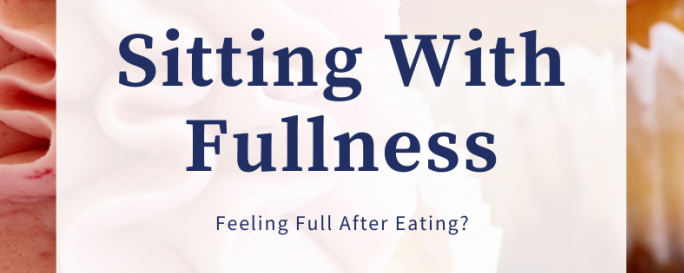Sitting With Fullness
It’s safe to say, eating disorder or not, you’ve likely had that uncomfortable feeling full after eating and sitting with the fullness.
Whether you just ate Thanksgiving dinner or you’re in recovery from an eating disorder, that feeling of fullness can not only be uncomfortable, but can also be a precursor to something worse.
It can lead to feelings of self-loathing, shame, more eating disorder behaviors, or perpetuate the binge-restrict cycle.
For me, as I was navigating how to eat again and how often, I became overwhelmed with feelings of ‘fullness’ that I had never experienced before. I wasn’t sure if they were entirely physical, mental or somewhere in between.
But, sitting with fullness was one of the hardest parts of breaking the cycle of behaviors.
I recently came across an essay I wrote while in yoga teacher training on Pema Chodron’s When Things Fall Apart.
In the report, I wrote on how I was coming to terms with fullness and how to sit with it. Additionally, this is a recurring topic I discuss with clients in my 1:1 coaching program.
I’d like to share three helpful tips to coping with feelings of fullness.
Feeling Full After Eating? Sitting with Fullness – 3 Tips
1) Change your mental state
What I mean by this is speak some affirmations and truth to your mind. Shift your mindset. Some powerful affirmations I practiced when feeling full after eating:
“this feeling of fullness is temporary”
“this will pass”
“my body knows what to do”
“trust my body”
2) Change your physical state
There are physical positions that aid digestion and ease that feeling of fullness. A quick google search will yield hundreds of poses. However, be cautious with clicking on these when in a vulnerable state.
Some of my go-to digestive poses are:
child’s pose
happy baby
yogi squat
In addition I made a digestive yoga video (admittedly I’m a little embarrassed by it; this was years ago, but hey it really helps).
3) Sit in the discomfort
Okay I’m sure you’re reading this and flipping me the middle finger at the same time. I know I would be.
Really, Lindsay, sit in the discomfort? Thanks, great advice.
But the discomfort is where you grow after all.
Sit in the fullness. Cry. Get pissed. Write about your feelings. Punch some pillows. Whatever you have to do when you’re feeling full after eating… but, then revisit key number one above. And tell yourself, this will pass. This feeling of fullness will go away.
The first time you sit with fullness, it will feel awful. The second time, still pretty awful. But the fifth, sixth, and fortieth time you start sitting with fullness? It’s less painful. You move on. Eventually you won’t even notice it.
Feeling full after eating isn’t the problem. It’s what we do with it. There are many options to sitting with fullness. Above I’ve only listed three.
The key is to be kind to yourself. Be gentle to yourself and know that sitting with it really is the best thing for you. The eating disorder will try to convince you to compensate or try to ‘beat you up’ and tell you what a terrible person you are. YOU know better. Go revisit these three tips – try one and let me know how it goes!
Finally if you want more tips like this, make sure you’re on my two action Tuesday list – where you get tangible actions each Tuesday on how to navigate recovery.




